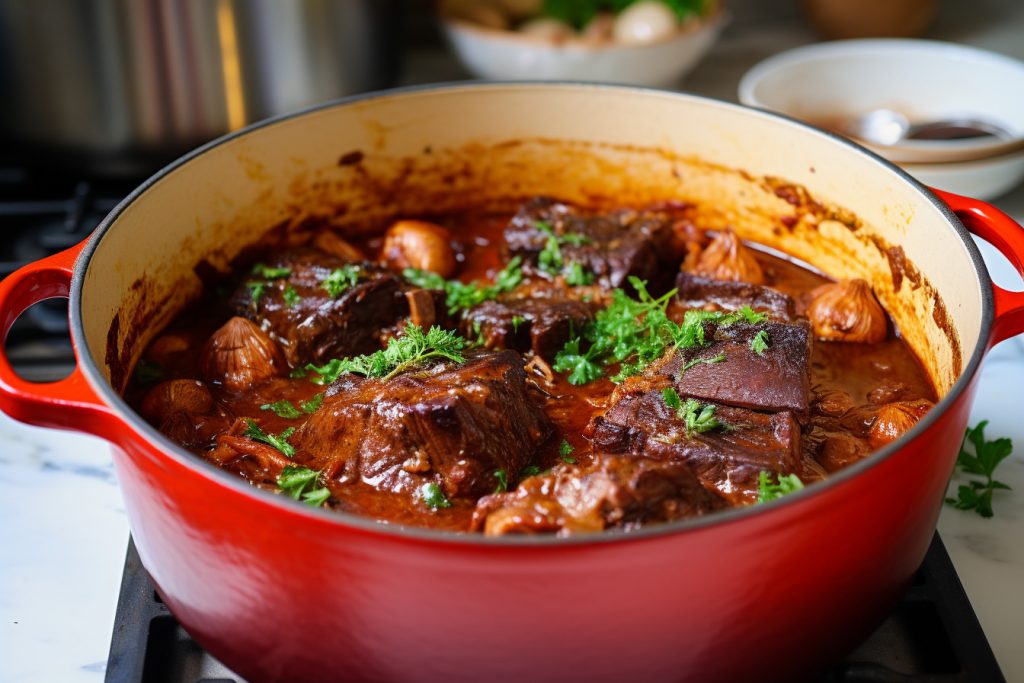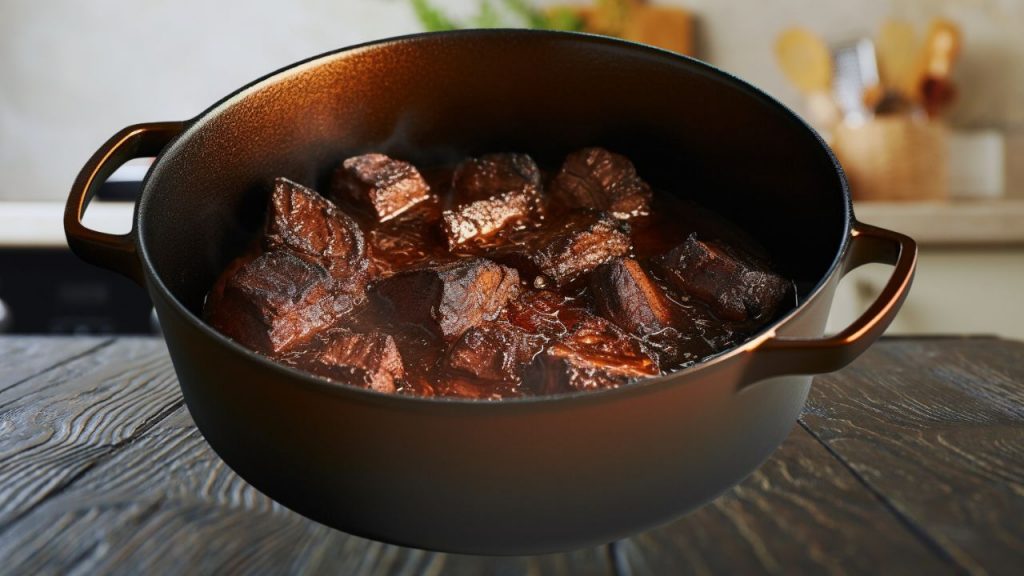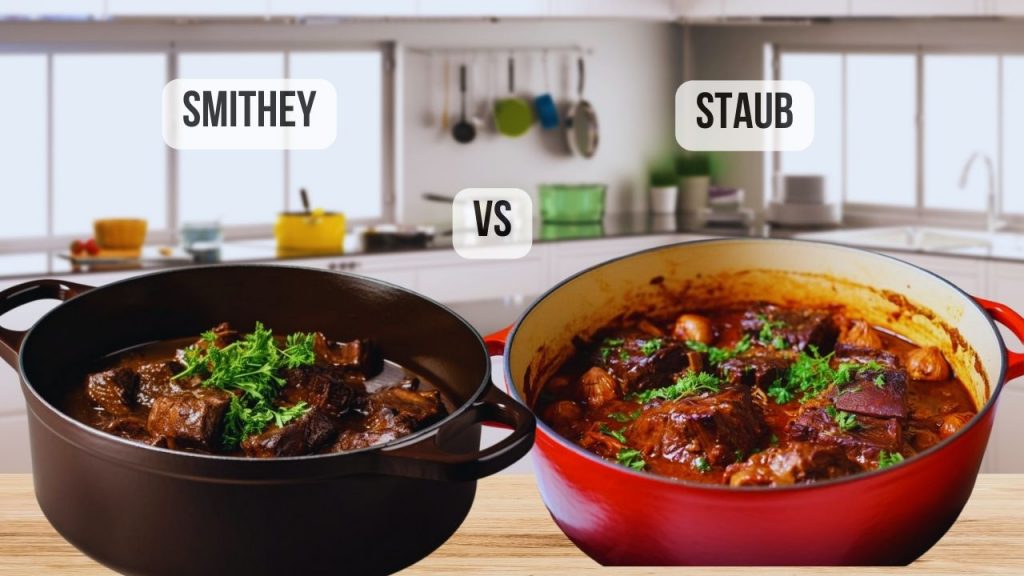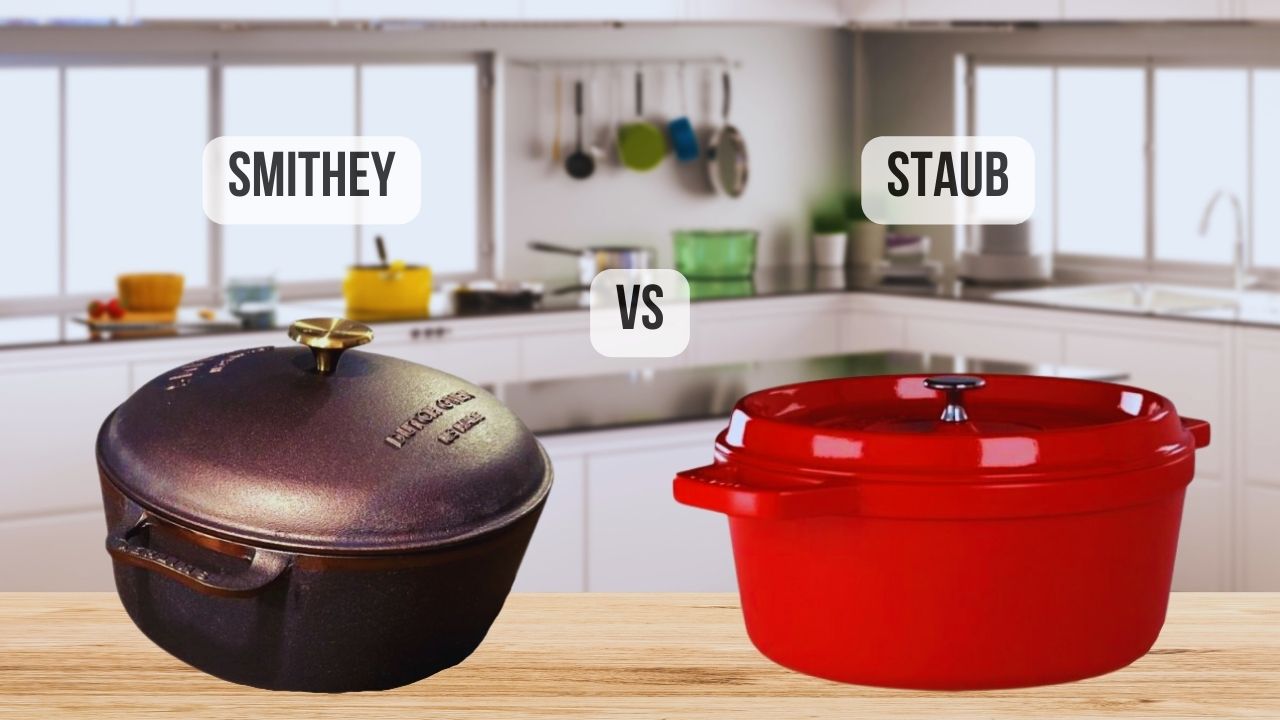As a seasoned restaurant chef with a decade of experience, I’ve had the opportunity to use a variety of kitchen tools and cookware. In this article, I’m focusing on a comparison between two well-known Dutch ovens: the Smithey Dutch Oven and the Staub Dutch Oven. These are both favored choices among home cooks and professional chefs alike.
To ensure a thorough comparison, I will evaluate the following key aspects:
- Material
- Weight
- Heat retention and compatibility
- Lid fit
- Handles and product design
- Colors
- Maintenance and cleaning
- Durability and performance
- Warranty
- Price
The Smithey Dutch Oven is a culinary masterpiece crafted with meticulous attention to detail. This Dutch oven is one of my favorites, as I am captivated by its sturdiness, premium materials, and timeless design.
Staub is a popular premium cookware brand. I purchased the Staub 5-quart Round Cocotte Dutch Oven and was excited to try it out.
These two Dutch ovens have achieved recognition as TOP-5 options of dutch ovens on the market.
We’ll start by taking a close look at each of these Dutch ovens, and then dive into the details of how they differ and which one might best meet your cooking needs.
In this review, I provide an independent assessment of the pros and cons of Smithey and Staub, based on my experience as a chef. If you choose to purchase it, please consider using the referral links included in this article. I earn a small commission from your purchases at no additional cost to you, which helps support this blog. Thank you!
Smithey VS Staub: Material
| Smithey | Staub |
|---|---|
| Smithey Dutch Ovens are crafted from high-quality cast iron. They are hand-finished with a polished interior and a matte enameled exterior. Hence, it gives them a sleek and premium appearance. | Staub Dutch Ovens are constructed from high-quality cast iron, which is renowned for its excellent heat retention and even heat distribution. The interior is coated with an enamel glaze that prevents rust and food from sticking. |
Smithey VS Staub: Weight
| Smithey | Staub |
|---|---|
| Because of its high-quality construction, Smithey Dutch Ovens are known for their heft. While the material used proves its durability, it can be a drawback for some people who are not used to heavy cookware. | Staub Dutch Ovens tend to be on the heavier side due to their cast iron construction. While this weight is excellent for retaining heat, it might be a concern for those who prefer lightweight cookware. |
Smithey VS Staub: Heat Retention and Compatibility
| Smithey | Staub |
|---|---|
| The Smithey Dutch Oven excels in heat retention, making it ideal for precise temperature control during cooking. Its cast iron body retains heat exceptionally well, which is crucial for recipes like braised short ribs, where a steady simmer is needed to tenderize the meat and enhance flavors. The Dutch oven’s compatibility with various heat sources, including stovetops, ovens, and open flames, allows for a seamless transition from searing to slow braising. | The Staub Dutch Oven excelled in heat retention. It maintains the temperature throughout the cooking process consistently. It is versatile and suitable for various cooking methods. It performed exceptionally well on both the stovetop and oven. |
Smithey VS Staub: Lid Fit
| Smithey | Staub |
|---|---|
| The Smithey Dutch Oven comes with a well-fitting lid that helps to trap moisture and heat effectively, ensuring your dishes come out perfectly cooked. It has self-basting spikes under the lid to ensure even moisture and flavor distribution, improving the taste and texture of dishes. | The tight-fitting lid in Staub Dutch Ovens ensures a snug seal, trapping moisture and flavor inside the pot, making it ideal for long-simmering dishes. |
Smithey VS Staub: Handles and Product Design
| Smithey | Staub |
|---|---|
| The handles of the Dutch oven are thoughtfully crafted, offering a comfortable hold and effortless control. The handles’ ergonomic design makes it easy to lift and maneuver even when carrying a heavy pot filled with food. The Dutch oven’s elegant appearance combines classic allure with modern sophistication. Smithey Dutch ovens truly serve as authentic, eye-catching centerpieces in any kitchen. | The Staub Dutch Oven features ergonomic handles, although I find the space a bit narrow. It makes it slightly challenging to lift the pot, especially when wearing oven mitts. Despite this handle design concern, the Dutch Oven’s overall product design is stylish and aesthetically pleasing. Its striking enameled exterior adds an elegant touch to the kitchen, making it a versatile piece suitable for cooking and serving. |
Smithey VS Staub: Colors
| Smithey | Staub |
|---|---|
| Smithey offers a limited color range. It has an enameled exterior, typically featuring a classic black finish. | Staub offers various elegant and vibrant colors to match your kitchen decor. |
Smithey VS Staub: Maintenance and Cleaning
| Smithey | Staub |
|---|---|
| While cast iron requires a tad more maintenance than nonstick alternatives, the Smithey Dutch Oven‘s smooth interior enamel makes cleaning a relatively straightforward task. I only need to soak it briefly and scrub it gently with a non-abrasive sponge to remove cooking residues. It’s essential to ensure thorough drying and apply a light oil coating to prevent rust to maintain its optimal condition. | Maintaining the Staub Dutch Oven is a breeze. The enamel interior is resistant to staining and remarkably easy to clean. After hours of slow-cooking the short ribs, I only needed a brief soak and a gentle scrub to have it looking as good as new. |
Smithey VS Staub: Durability and Performance
| Smithey | Staub |
|---|---|
| Smithey undeniably upholds its dedication to durability, meticulously crafting this Dutch oven with top-tier materials. The Dutch oven’s remarkable performance makes it a wise long-term investment. By giving proper care and maintenance, this Dutch oven can endure for many years and become a cherished heirloom passed down to the next generation. | Staub Dutch Ovens are renowned for their durability and performance. They can last a lifetime if well-maintained and are a chef’s favorite for slow-cooked stews and braises. |
Smithey VS Staub: Warranty
| Smithey | Staub |
|---|---|
| Smithey offers a limited lifetime warranty on their Dutch Ovens. This warranty reflects the company’s confidence in the product’s durability. | Staub provides a lifetime warranty with certain limitations for their cast iron cookware. This warranty addresses functional, material, and manufacturing defects found in cast iron cookware. |
Smithey VS Staub: Price
| Smithey | Staub |
|---|---|
| Smithey Dutch Ovens are on the higher end of the price spectrum, justifying the investment with premium materials and craftsmanship. | Staub Dutch Ovens are an investment with a price point that reflects their quality. They may not be the most budget-friendly option, but their longevity and performance make them worth it. |
Cooking Test

During our cooking experiment, we made Red Wine Braised Short Ribs in both the Smithey and Staub Dutch Ovens. This exercise helped us evaluate the performance of each Dutch oven based on three key factors: the effectiveness of browning, how well they retained moisture, and the overall taste of the prepared dish.
Browning

Getting the meat to sear perfectly is the first step in making delicious Red Wine Braised Short Ribs.
So far, both Dutch ovens have produced a beautiful sear on the ribs, enhancing the overall flavor and texture of the final dish.
Moisture Retention
Both Dutch ovens exhibited impressive moisture retention capabilities during the lengthy braising process. The Smithey Dutch Oven is renowned for its ability to maintain a consistent simmer. It ensured that the short ribs remained juicy and tender. The braising liquid clung to the meat, resulting in a perfectly moist final dish.
Final Flavor

Both the Smithey and Staub Dutch Ovens contributed to an extraordinary culinary experience. In the Smithey Dutch Oven, precise temperature control allowed the flavors to meld harmoniously. The short ribs developed a remarkable depth of flavor, their taste rich and satisfying.
How We Tested
I conducted a detailed cooking test with Red Wine Braised Short Ribs to compare the performance of the Smithey and Staub Dutch Ovens. To maintain fairness, I used the same cooking method for both ovens.
The test began with an assessment of their browning capabilities, focusing on how effectively they seared the meat. Next, I evaluated their ability to retain moisture, a vital aspect for a dish that requires extended braising. Finally, I assessed the depth and richness of the flavors to determine the overall quality of the dishes.
Our evaluation was thorough and uniform, ensuring a precise comparison of the Smithey and Staub Dutch Ovens in these essential areas.
Conclusion: Smithey is The Winner
In conclusion, after a comprehensive evaluation and cooking test, the Smithey Dutch Oven emerges as the clear winner in this comparison. As a seasoned chef with extensive experience in using various cookware, I found the Smithey Dutch Oven to outshine its competitor in several critical aspects.
While both the Smithey and Staub Dutch Ovens excel in browning, moisture retention, and contributing to the final flavor of dishes, it’s the subtle but significant advantages of the Smithey that make it stand out. Its superior ability to maintain a consistent simmer is particularly noteworthy, ensuring that dishes like Red Wine Braised Short Ribs stay juicy and tender. This feature, coupled with its excellent heat retention and compatibility across various heat sources, makes the Smithey Dutch Oven an invaluable tool in the kitchen.
However, if you are looking for an affordable Dutch oven for home cooking, then, Smithey might be a good option for you. If you decide to purchase it, please use my referral link.

